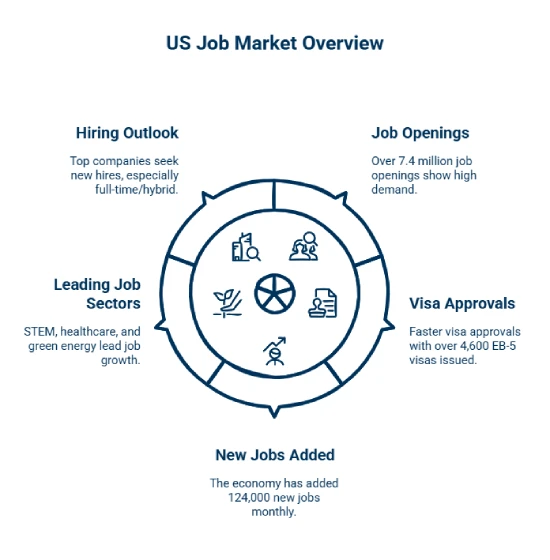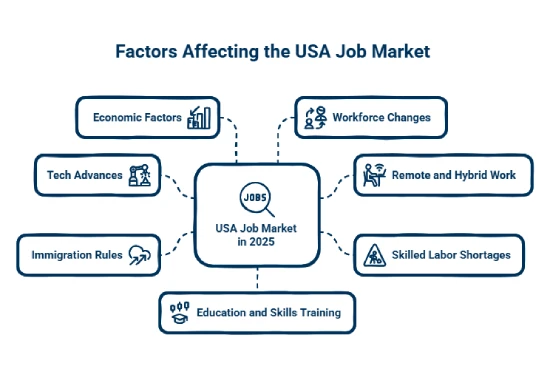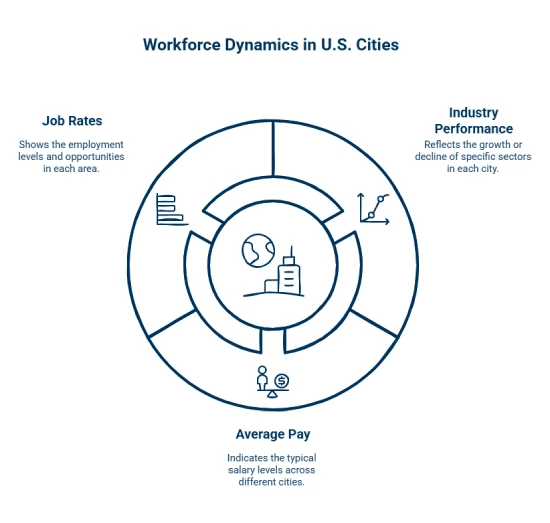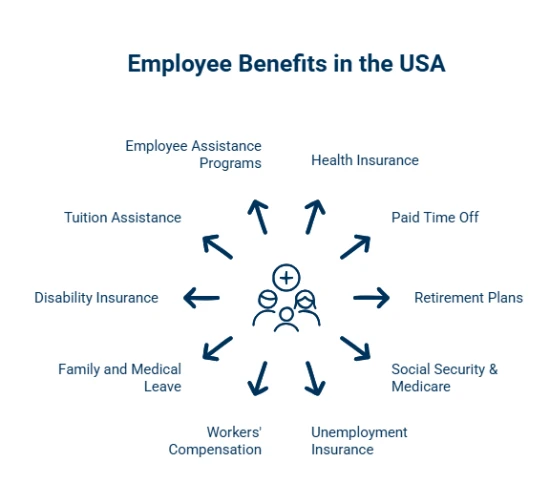Job Market in the USA 2025-26
- The U.S. has more than 7.4 million job openings, indicating a strong demand for workers in various fields.
- Visa approvals are faster with over 4,600 EB-5 visas issued in the first quarter of FY2025.
- The economy added about 124,000 new jobs each month this year
- Jobs in STEM, healthcare, and green energy are really leading the way for growth.
- Many top companies are on the lookout for new hires, especially for full-time and hybrid positions.

USA Job Outlook
The U.S. job market in 2025 is looking lively and strong, thanks to innovation and steady hiring. There are millions of job openings, especially in hot industries like tech, healthcare, and green energy, which creates good chances for skilled workers. While some areas and sectors are seeing changes in hiring patterns, overall, people are still actively participating in the workforce. Trends like digital transformation, remote work, and changes in immigration rules are shaping the job scene in the U.S.
Here are some key factors affecting the USA job market in 2025:
- Tech Advances: New tools and automation are changing job roles and the skills needed.
- Remote and Hybrid Work: Flexible work styles are changing how and where people get their jobs done.
- Skilled Labor Shortages: There’s a high need for workers in healthcare, IT, and engineering, but local supply cannot keep up.
- Immigration Rules: Changes in visa laws are affecting how international talent moves into the job market.
- Economic Factors: Things like GDP growth, inflation, and interest rates are influencing hiring decisions.
- Workforce Changes: An older workforce combined with new Gen Z workers is changing what people expect from jobs.
- Education and Skills Training: There is a growing focus on vocational training and upskilling to meet what employers are looking for.

In-Demand Jobs in the USA
The U.S. job market has a huge demand for skilled workers across different fields. The demand comes from things like new technologies, an older population, and a shift in the economy. Industries like healthcare, tech, logistics, and renewable energy are on the lookout for new hires, and they are offering good pay and chances for long-term growth.
|
Occupations |
Salary (per annum) |
|
Engineering |
$99,937 |
|
IT |
$78,040 |
|
Marketing & Sales |
$51,974 |
|
Human Resources |
$60,000 |
|
Healthcare |
$54,687 |
|
Teachers |
$42,303 |
|
Accountants |
$65,000 |
|
Hospitality |
$35,100 |
|
Nursing |
$39,000 |
Read more…
Top In demand jobs in the USA
Workforce requirements in different cities in the USA
The job market in the U.S. is varied, and differs based on the cities. Factors such as how industries are doing, average pay, and job rates change from one area to another, giving job seekers different options.

Given below is the list of the top 10 U.S. cities with a strong demand for workers, along with their average salaries and job growth rates.
|
City |
Average Annual Salary |
Employment Growth Rate |
|
Scottsdale, AZ |
$107,372 |
2.80% |
|
Pittsburgh, PA |
$66,796 |
3.50% |
|
Columbia, MD |
$129,173 |
1.80% |
|
South Burlington, VT |
$70,000 (est.) |
4.20% |
|
Portland, ME |
$77,286 |
3.76% |
|
Charleston, SC |
$65,000 (est.) |
3.00% |
|
Chandler, AZ |
$85,000 (est.) |
2.50% |
|
Washington, D.C. |
$106,287 |
3.20% |
|
Tempe, AZ |
$80,000 (est.) |
2.70% |
|
Orlando, FL |
$75,000 (est.) |
3.10% |
In-demand skills in the USA
The U.S. job market is changing, and employers are looking for both technical and good people skills. Skills in areas like AI, data analysis, and cybersecurity are in high demand, but being able to communicate well, lead a team, and adapt to change is still really important no matter the job.
The table below has details of the top in-demand skills that can help you in the American workforce:
|
Technology Skills |
Marketing Skills |
Finance & Accounting Skills |
Healthcare Skills |
Leadership & Communication Skills |
|
Artificial Intelligence (AI) & Machine Learning |
Digital Marketing |
Financial Analysis |
Clinical Expertise |
Effective Communication |
|
Data Analysis & Visualization |
Content Creation |
Accounting Proficiency |
Health Informatics |
Team Leadership |
|
Cybersecurity |
Search Engine Optimization (SEO) |
Budgeting and Forecasting |
Telemedicine |
Emotional Intelligence |
|
Cloud Computing |
Social Media Management |
Risk Management |
Patient Care Coordination |
Adaptability |
|
Software Development |
Data-Driven Marketing |
Financial Reporting |
Medical Coding and Billing |
Strategic Thinking |
|
Block chain |
|
|
|
|
Remote work in the USA
Remote work is a big part of the U.S. job market. About 32.6 million Americans, or 22% of the workforce, are working from home. Additionally, around 28.2% of full-time employees are following a hybrid model, mixing both remote and in-office work. This change marks a shift from how things were done before the pandemic.
Workers clearly want flexible options, with 98% saying they would like to work from home at least sometimes. Companies are responding, with 16% fully remote and 63% offering hybrid setups.
Overall, remote work in the U.S. is a key part of the job market, as it finds a balance between what employees want and what companies need.
*Want to migrate to the USA? Sign up with Y-Axis for complete immigration assistance!
US Government Policies & Initiatives
In 2025, the U.S. government rolled out several new policies that affect federal employees. These changes are meant to improve how things work, alter benefits, and change some workforce structures.
Here’s a quick look at the latest US government policies:
- Department of Government Efficiency (DOGE) Initiative
This initiative aims to modernize how federal agencies operate. It focuses on cutting out unnecessary steps and boosting productivity within departments, like Health and Human Services, while keeping essential services intact.
- Deferred Resignation Program (DRP)
With this program, eligible federal employees can choose to resign but still receive their full pay and benefits until September 30, 2025. It's part of efforts to streamline the workforce and is being used in several departments, including the Department of Defense.
- Federal Hiring Freeze
There’s currently a temporary freeze on hiring for federal civilian jobs, though some exceptions apply. This move is designed to shrink the federal workforce and help keep costs in check.
- Reinstatement of Schedule F
This change reclassifies some roles that influence policy, loosening protections for those jobs and focusing on making sure employees perform well. It's meant to make it easier to let go of those who aren’t meeting expectations and to get the right people in line with current policy goals.
- Executive Order 14173: Ending DEIA Programs
This order stops private groups from running Diversity, Equity, Inclusion, and Accessibility programs if they relate to jobs tied to federal contracts. It also cancels some earlier orders about non-discrimination in federal contracting.
Employee Benefits in the USA
Employees in the U.S. can get a variety of benefits that support their health, finances, and balance between work and life. These benefits can differ based on the employer and job role.
Some of the employee benefits in the USA are as follows:
- Health Insurance: Most companies provide health insurance that covers medical, dental, and vision costs for employees and often their families. These plans usually include things like check-ups, hospital stays, and visits to specialists.
- Paid Time Off (PTO): Employees get paid time off for vacations, personal time, sick days, and holidays. Usually, the amount of PTO goes up the longer you stay with the company.
- 401(k) Retirement Plans: A 401(k) is a savings plan that lets employees set aside part of their paycheck before taxes for retirement. Lots of employers will match some of what you put in, which helps you save for the future.
- Social Security & Medicare: These federal programs are paid for through payroll taxes. Social Security gives retirement and disability benefits, while Medicare provides health coverage for people over 65 or with specific health issues.
- Unemployment Insurance: This benefit gives temporary financial help to workers who lose their jobs through no fault of their own, helping them cover expenses while they look for a new job.
- Workers’ Compensation: If you are injured at work, you can get medical care and some pay replacement through workers' compensation, protecting you from workplace accidents.
- Family and Medical Leave (FMLA): Employees who qualify can take up to 12 weeks off without pay for family or medical reasons, like having a baby, dealing with serious health problems, or caring for a family member.
- Disability Insurance: Short-term and long-term disability insurance gives you some income if you cannot work due to illness or injury.
- Tuition Assistance & Professional Development: Some employers pay back employees for tuition or training courses that help them learn new skills and move up in their careers.
- Employee Assistance Programs (EAPs): EAPs provide private counseling and mental health help with issues like stress, substance abuse, financial planning, and family problems.

Job Opportunities in the US: Challenges for Job Seekers
The U.S. is a popular spot for skilled workers from around the globe, offering plenty of job choices in various fields. But even with a lively job market, those looking for work might run into some bumps along the way. These include tricky visa issues, stiff competition, and shifting job requirements. Knowing what these challenges are can really help when trying to find a job and make a career here.
- Visa and Work Authorization Issues: Many jobs need sponsorship for work visas, like the H-1B, which has limits and a random selection process, making it tough to get one.
- Intense Job Market Competition: The U.S. market attracts talent from all over, so it's competitive for sought-after jobs, especially in tech, healthcare, and finance.
- Changing Immigration Policies: Frequent changes in immigration and labor laws can mess with timelines and job chances for foreign applicants.
- Recognition of Foreign Qualifications: Degrees and certifications from outside the U.S. might not be recognized, which could mean needing extra evaluations or licenses.
- Limited U.S. Work Experience: Employers often prefer candidates with local work experience or knowledge of American work culture and practices.
- High Cost of Living in Major Cities: Cities like New York, San Francisco, and Boston have plenty of job openings, but the cost of living can be a big drawback.
- Networking Challenges: Making connections in a new country can be tough, especially for recent immigrants or international graduates.
- Skill Gaps: Some job seekers may find their skills don’t match what employers are looking for, especially in fast-changing fields like AI and cybersecurity.
- Cultural and Communication Challenges: Getting used to U.S. workplace norms and communication styles can be hard, especially for those who are not native English speakers.
- Limited Access to Job Search Platforms: Many international job seekers might be unfamiliar with the best U.S. job search websites or recruiting firms that focus on visa-sponsored jobs.
*Finding it difficult to keep your resume up-to-date? Avail Y-Axis Resume Writing Services to get personalized assistance!
How to Navigate the USA Job Market Successfully?
Finding a job in the U.S. can be a bit tricky, so it helps to have a solid plan. With so many opportunities out there, you need to know the hiring landscape, make the most of your skills, and keep up with what employers are looking for. Whether you just graduated, have experience under your belt, or are looking for a job from another country, here are some handy tips to make your job search easier.
- Research Industry Trends: Look into fields that are growing, like healthcare, tech, and finance, and focus your job search on positions that are in demand.
- Tailor Your Resume: Customize your resume and cover letter for each job. Make sure to highlight the skills and experiences that match what they're asking for.
- Build Your Online Presence: Set up a professional LinkedIn profile that showcases your achievements and career goals. This can help get you noticed by employers.
- Use Reputable Job Portals: Go for well-known sites like Indeed, LinkedIn, and Glassdoor for job listings. Also, try to go to industry events or job fairs to meet recruiters in person.
- Get Ready for Interviews: Know what American employers expect during interviews. Be prepared for behavioral questions, show how you solve problems, and clearly communicate what you bring to the table.
USA Job Market Summary
The job market in the U.S. is looking good, with over 8 million job openings in 2024. There's solid demand in fields like healthcare, IT, engineering, and finance. The unemployment rate is around 3.7%, which shows that there are plenty of chances for skilled workers. You can really see job growth in cities like Austin, Seattle, and San Francisco. On average, people earn about $59,000 a year, but in some high-demand jobs, salaries can go over $100,000. With companies hiring more, changes in remote work policies, and support from the government, the U.S. is still a great place for talent from around the world looking for good career paths.
*Are you looking for step-by-step assistance for US Immigration? Contact Y-Axis, the leading visa and immigration consultancy in Canada!
Looking for Inspiration
Explore what Global Citizens have to say about Y-Axis in shaping their future
Frequently Asked Questions
